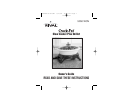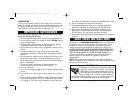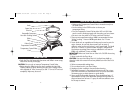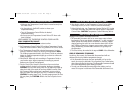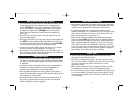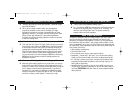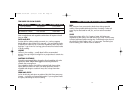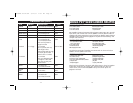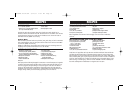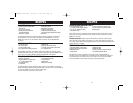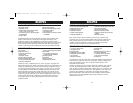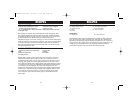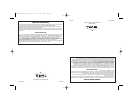
-9-
• Because there is direct heat at the bottom, always fill the Removable
Stoneware at least half full to conform to recommended times. Small
quantities may be prepared, but cooking time will be affected.
•A specific liquid called for in a recipe may be varied if an equal
quantity is substituted. (Such as substituting a 10
3
⁄4 ounce can of soup
plus 4 ounces of water for a 14
1
⁄2 ounce can of tomatoes OR
1
⁄2 cup
beef or chicken broth for
1
⁄2 cup of wine, etc.)
• Beans must be softened completely before combining with sugar
and/or acid foods (NOTE: Sugar and acid have a hardening effect on
beans and will prevent softening). Dried beans, especially red kidney
beans, should be boiled before adding to a recipe. Cover the beans
with 3 times their volume of unsalted water and bring to a boil. Boil
10 minutes, reduce heat, cover and allow to simmer 1
1
⁄2 hours or until
beans are tender. Soaking in water, if desired, should be completed
before boiling. Discard water after soaking or boiling.
SLOW COOKER HINTS (CONT.)
SKILLET HINTS
• Use only nylon or heat-proof plastic utensils. Metal utensils may
scratch the Non-Stick Cooking Surface.
• This Skillet is not designed to deep fry. To pan-fry, do not use more
than
1
⁄2 cup of oil. Select a vegetable oil or peanut oil for frying. Butter
and olive oil should only be used to sauté foods on a lower
temperature setting.
• When preparing foods not listed in Temperature Guide, start with a
low temperature and work up to desired cooking temperature.
• If Non-Stick Cooking Surface has been conditioned (see above), there
is no need for additional cooking oils or fats when cooking. A small
amount of butter, shortening or oil will however, add flavor and aid
in even browning.
•Trim fats and wipe meats well to remove residue. (If meats contain
fats, brown in a separate skillet or broiler and drain well before adding
to cooker.) Season with salt and pepper. Place meat in cooker on top
of vegetables.
• For roasts and stews, pour liquid over meat. Use no more liquid than
specified in the recipe. More juices in meats and vegetables are
retained in slow cooking than in conventional cooking.
•Most vegetables should be thinly sliced or placed near the sides or
bottom of the Removable Stoneware. Meats generally cook faster than
most vegetables in a Slow Cooker.
•Use whole leaf herbs and spices for the best and truest flavor for all-
day cooking. If ground herbs and spices are used, they should be
stirred in during the last hour of cooking.
-8-
HOW TO CLEAN YOUR ELECTRIC SKILLET
1. Turn Temperature Control Dial to OFF. After Skillet has cooled, remove
Temperature Control Probe (make sure that it is unplugged from
outlet). CAUTION: Do not immerse Temperature Control Probe in
water or other liquids. Temperature Control Probe may be cleaned
by wiping with a damp cloth. CAUTION: Always make sure that
Probe Guard and Temperature Control Probe are completely dry
prior to use.
2. Wash Glass Lid in hot soapy water or top rack of dishwasher, then
rinse thoroughly and dry.
3. Thoroughly wash Skillet in hot soapy water, then rinse thoroughly and
dry. NOTE: To remove stubborn stains from Skillet or Glass Lid, use a
non-abrasive cleaner such as Bon-Ami
®
polishing cleanser. CAUTION:
Do not use metal scouring pads or harsh abrasive powders.
4. In time, the Non-Stick Cooking Surface may discolor. This is normal
and will not alter its Non-Stick properties. To remove any
discoloration, use a commercial cleaner for Non-Stick finishes such as
Dip-It
®
coffeepot destainer. Follow package directions. Recondition the
Non-Stick Cooking Surface before using again.
SLOW COOKER HINTS
5050WCN.02.CN.OM1 6/27/02 11:17 AM Page 8



